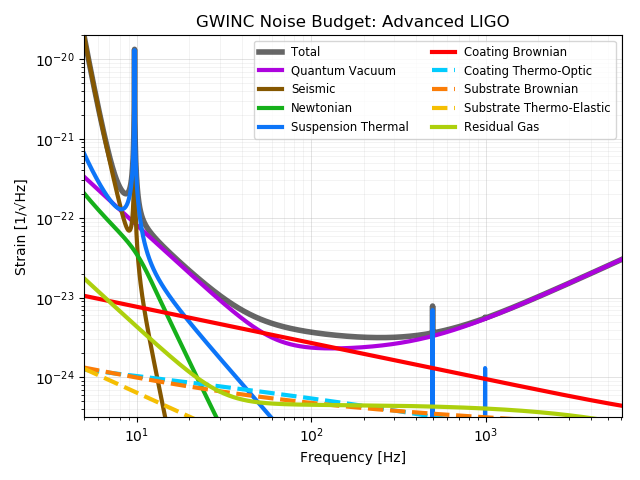-
Jameson Rollins authored
This specifies a default frequency array for load_budget and the CLI, and makes it easier to provide alternative arrays with a frequency "specification string" (e.g. '5:1000:3000').
Jameson Rollins authoredThis specifies a default frequency array for load_budget and the CLI, and makes it easier to provide alternative arrays with a frequency "specification string" (e.g. '5:1000:3000').
Python Gravitational Wave Interferometer Noise Calculator
pygwinc is a multi-faceted tool for processing and plotting noise
budgets for ground-based gravitational wave detectors. It's primary
feature is a collection of mostly analytic noise calculation
functions for various sources of noise affecting
detectors (gwinc.noise):
- quantum noise
- mirror coating thermal noise
- mirror substrate thermal noise
- suspension fiber thermal noise
- seismic noise
- Newtonian/gravity-gradient noise
- residual gas noise
pygwinc is also a generalized noise budgeting tool (gwinc.nb) that
allows users to create arbitrary noise budgets (for any experiment,
not just ground-based GW detectors) using measured or analytically
calculated data. See the budget interface
section below.
pygwinc includes canonical budgets for various well-known current
and future GW detectors (gwinc.ifo):
See IFO.md for the latest CI-generated plots and hdf5 cached data.
The inspiral_range
package can be used to calculate various common "inspiral range"
figures of merit for gravitational wave detector budgets. See the
inspiral range section below.
usage
command line interface
pygwinc provides a command line interface that can be used to
calculate and plot the various canonical IFO noise budgets described
above, as well as custom noise budgets (see below):
$ python3 -m gwinc aLIGOBudget plots save/plot hdf5 trace data, and dump budget IFO parameters:
You can play with IFO parameters and see the effects on the budget by dumping the pre-defined parameters to a YAML-formatted parameter file, editing the parameter file, and re-calculating the noise budget:
$ python3 -m gwinc --yaml aLIGO > my_aLIGO.yaml
$ edit my_aLIGO.yaml
$ python3 -m gwinc -d my_aLIGO.yaml aLIGO
aLIGO my_aLIGO.yaml
Materials.Coating.Philown 5e-05 3e-05
$ python3 -m gwinc my_aLIGO.yamlYou can also use the --ifo option to change parameters from the
command line:
$ python3 -m gwinc aLIGO --ifo Optics.SRM.Tunephase=3.14Stand-alone YAML files assume the nominal 'aLIGO' budget description.
Custom budgets may also be processed by providing the path to the budget module/package:
$ python3 -m gwinc path/to/mybudgetThe command line interface also includes an "interactive" mode which provides an IPython shell for interacting with a processed budget:
$ python3 -m gwinc -i Aplus
GWINC interactive shell
The 'ifo' Struct and 'trace' data are available for inspection.
Use the 'whos' command to view the workspace.
You may interact with the plot using the 'plt' functions, e.g.:
In [.]: plt.title("My Special Budget")
In [.]: plt.savefig("mybudget.pdf")
In [1]: See command help for more info:
$ python3 -m gwinc -hlibrary interface
For custom plotting, parameter optimization, etc. all functionality can be
accessed directly through the gwinc library interface:
>>> import gwinc
>>> budget = gwinc.load_budget('aLIGO')
>>> trace = budget.run()
>>> fig = gwinc.plot_budget(trace)
>>> fig.show()A default frequency array is used, but alternative frequencies can be
provided to load_budget() either in the form of a numpy array:
>>> import numpy as np
>>> freq = np.logspace(1, 3, 1000)
>>> budget = gwinc.load_budget('aLIGO', freq=freq)or frequency specification string ('FLO:[NPOINTS:]FHI'):
>>> budget = gwinc.load_budget('aLIGO', freq='10:1000:1000')The load_budget() function takes most of the same inputs as the
command line interface (e.g. IFO names, budget module paths, YAML
parameter files), and returns the instantiated Budget object defined
in the specified budget module (see budget
interface below). The budget ifo gwinc.Struct
is available in the budget.ifo attribute.
The budget run() method calculates all budget noises and the noise
total and returns a BudgetTrace object with freq, psd, and asd
properties. The budget sub-traces are available through a dictionary
(trace['QuantumVacuum']) interface and via attributes
(trace.QuantumVacumm).
The budget freq and ifo attributes can be updated at run time by
passing them as keyword arguments to the run() method:
>>> budget = load_budget('aLIGO')
>>> freq = np.logspace(1, 3, 1000)
>>> ifo = Struct.from_file('/path/to/ifo_alt.yaml')
>>> trace = budget.run(freq=freq, ifo=ifo)noise functions
The pygwinc analytical noise functions are available in the
gwinc.noise package. This package includes multiple sub-modules for
the different types of noises, e.g. suspensionthermal,
coatingthermal, quantum, etc.)
The various noise functions need many different parameters to
calculate their noise outputs. Many parameters are expected to be in
the form of object attributes of a class-like container that is passed
to the calculation function. The pygwinc
Struct object is designed to hold such
parameters.
For instance, the coating_brownian function expects a materials
structure as input argument, that holds the various mirror materials
parameters (e.g. materials.Substrate.MirrorY):
def coating_brownian(f, materials, wavelength, wBeam, dOpt):
...
# extract substructures
sub = materials.Substrate
...
# substrate properties
Ysub = sub.MirrorY
gwinc.Struct objects
pygwinc provides a Struct class that can hold parameters in
attributes and additionally acts like a dictionary, for passing to the
noise calculation functions. Structs can be created from
dictionaries, or loaded from various file formats (see below).
YAML parameter files
The easiest way to store all budget parameters is in a YAML file.
YAML files can be loaded directly into gwinc.Struct objects via
the Struct.from_file() class method:
from gwinc import Struct
ifo = Struct.from_file('/path/to/ifo.yaml')YAML parameter files can also be given to the load_budget() function
as described above, in which case the base 'aLIGO' budget structure
will be assumed and returned, with the YAML Struct inserted in the
Budget.ifo class attribute.
Here are the included ifo.yaml files for all the canonical IFOs:
